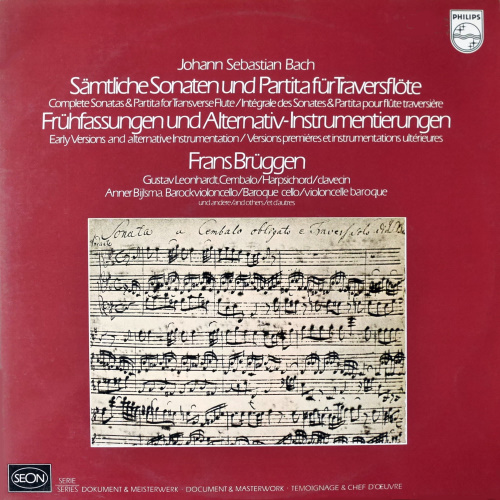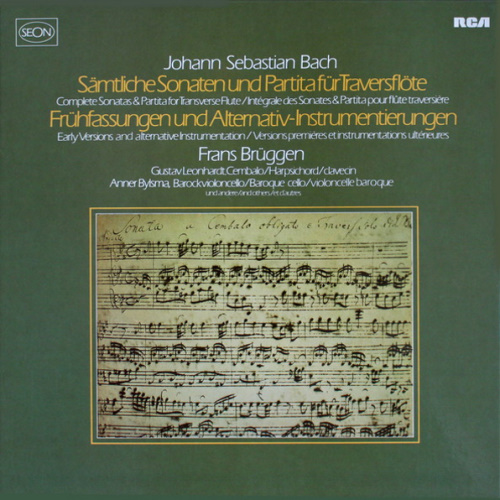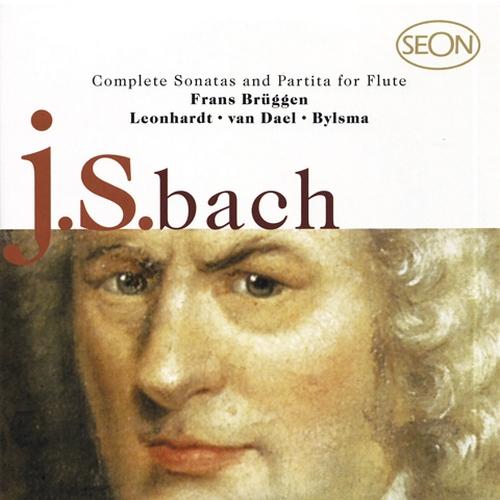 |
2 LPs
- 6775 022 - (p) 1976
|
 |
2 LPs -
RL 30426 - (p) 1980
|
 |
| 2 CD -
SB2K 60718 - (c) 1998 |
|
| SÄMTLICHE
SONATEN UND PARTITA FÜR TRAVERSFLÖTE |
FRÜHFASSUNGEN UND
ALTERNATIV-INSTRUMENTIERUNGUNGEN |
|
|
|
|
|
|
|
| Johann Sebastian
BACH (1685-1750) |
Sonate
(I) in B Minor for Transverse Flute and
Harpsichord, BWV 1030 |
|
16' 24" |
|
|
-
Andante |
8' 29" |
|
A1
|
|
-
Largo e dolce |
4' 21" |
|
A2 |
|
-
Presto
|
5' 34" |
|
A3 |
|
Frans Brüggen | Gustav Leonhardt
|
|
|
|
|
Sonate
(III) in E Major for Transverse Flute
and Basso continuo, BWV 1035 |
|
13' 45" |
|
|
-
Adagio ma non tanto
|
2' 44" |
|
B1 |
|
-
Allegro |
3' 19" |
|
B2 |
|
-
Siciliano |
4' 33" |
|
B3 |
|
-
Allegro assai
|
3' 09" |
|
B4 |
|
Frans Brüggen | Gustav Leonhardt
| Anner Bijlsma
|
|
|
|
|
Sonate (III) in A Major for
Transverse Flute and Harpsichord,
BWV 1032 |
|
13' 09" |
|
|
-
Vivace (completed by Gerrit de Marez
Oyens)
|
5' 30" |
|
B5 |
|
-
Largo e dolce
|
3' 32" |
|
B6 |
|
-
Allegro |
4' 07" |
|
B7 |
|
Frans Brüggen | Gustav Leonhardt |
|
|
|
|
Sonate
(II) in E Minor for Transverse Flute
and Basso continuo, BWV 1034
|
|
14' 02" |
|
|
-
Adagio ma non tanto
|
3' 36" |
|
C1 |
|
-
Allegro |
2' 35" |
|
C2 |
|
-
Andante |
3' 31" |
|
C3 |
|
-
Allegro
|
4' 20" |
|
C4 |
|
Frans Brüggen | Gustav Leonhardt
| Anner Bijlsma |
|
|
|
|
Partita
in A Minor for Transverse Flute solo,
BWV 1013 |
|
12' 50" |
|
|
-
Allemande |
4' 33" |
|
C5 |
|
-
Courante |
2' 48" |
|
C6 |
|
-
Sarabande |
3' 49" |
|
C7 |
|
-
Bourrée angloise
|
1' 40" |
|
C8 |
|
Frans Brüggen |
|
|
|
|
ALTERNATIVE
INSTRUMENTATION FOR PARTITA IN A MINOR,
BWV 1013: |
|
|
|
|
- Allemande
- (1st movement) in G Minor for viola
|
|
5' 44" |
D1 |
|
Lucy van Dael |
|
|
|
|
- Allemande
- (1st movement) in A Minor for
harpsichord (version by Gustav Leonhardt)
|
|
3' 21" |
D2 |
|
Gustav Leonhardt |
|
|
|
|
- Corrente
- (2nd movement) in G Minor for
violoncello piccolo
|
|
2' 58" |
D3 |
|
Anner Bijlsma |
|
|
|
|
- Sarabande
- (3rd movement) in C minor for recorder
|
|
4' 11" |
D4 |
|
Frans Brüggen |
|
|
|
|
- Bourrée
angloise - (4th movement) in G Minor
for violin
|
|
1' 54" |
D5 |
|
Lucy van Dael |
|
|
|
|
Concerto
in D Minor, FRAGMENT after the 1st
movement (Andante) of the Sonata in B
Minor, BWV 1030
|
|
4' 18" |
D6 |
|
for
transverse flute and harpsichord in a
version by Frans Brüggen
|
|
|
|
|
Sigiswald Kuijken | Lucy van
Dael | Wieland Kuijken | Adelheid Glatt
| Anner Bijlsma | Anthony Woodrow |
Gustav Leonhardt |
|
|
|
|
|
|
|
|
Frans
Brüggen, Transverse
flute
Gustav Leonhardt, Harpsichords
Anner Bijlsma, Baroque cello
Lucy van Dael, viola
Sigiswald Kuijken, violin I
Wieland Kuijken, Viola da gamba
I
Adelheid Glatt, Viola da gamba
II
Anthony Woodrow, Violone
|
The Instruments
- Transverse flute (I. Scherer, Southern
Germany or France, 1733)
- Recorder (Frederick Morgan, after Bizey,
France, 18th century)
- Violin I (Maggini School, Brescia,
Mid-17th century) - Concerto in D Minor
- Violin II (Gennario Gagliano, Naples,
1732) - Concerto in D Minor, Bourrée
angloise
- Viola (Samuel Thompson, London, 1751)
- Violoncello piccolo (Klotz, c.1800)
- Baroque violoncello (Mattio Gofrilleri,
Venice, 1695)
- Viola da Gamba I (Tirol, 18th century)
- Viola da Gamba II (Anon., Southern Germany
or Tyrol, 18th century (7-saiting)
- Violone (Jaap Bolink, Amsterdam, 1972)
- Harpsichord (Martin Skowroneck, Bremen,
1974, French style) - BWV 1030, 1032
- Harpsichord (David Rubio, Oxford, 1975
after Pascal Taskin, ca. 1760) - BWV
1034, 1035, Concerto in D Minor, Allemande
|
|
|
|
|
|
Luogo
e data di registrazione |
|
Doopsgezinde Kerk,
Amsterdam (Holland) - Febbraio
1975
|
|
|
Registrazione: live
/ studio |
|
studio |
|
|
Producer /
Recording Supervisor |
|
Wolf Erichson
|
|
|
Recording Engineer
|
|
Dieter Thomsen
|
|
|
Prima Edizione LP |
|
Seon (Philips) | 6775
022 | 2 LP - durata 46' 11" - 50'
55" | (p) 1976 | ANA
Seon (RCA Red Seal) | RL 30426 | 2
LPs - durata 46' 11" - 50' 55" |
(p) 1980 | ANA
|
|
|
Edizione CD |
|
Sony | SB2K 60718 | 2
CDs - durata 46' 11 - 50' 55"" |
(c) 1999 | ADD
|
|
|
Original Cover
|
|
First page of the
Sonata in B Minor, in Bach's hand.
|
|
|
Note |
|
-
|
|
|
|
|
Facts
This recording comprises all
the works for soloflute,
with obbligato harpsichord
or with basso continuo, by
Johann Sebastian Bach
included in the “Neue
Bach-Ausgabe”. (See
“Critical Remarks” on the
“N.B.A.”, Series VI., Vol.
3, 1963, by Hans-Peter
Schmitz.)
Opinions
For their imagination,
daring and liveliness of
expression we are keeping to
Hans Eppstein and his
“Studien über J. S. Bachs
Sonaten für ein
Melodieinstrument und
obligates Cembalo” (1966)
and “Über J. S. Bachs
Flötensonaten mit
Generalbass” (1972, Bach
Year Book 58).
His partial, even at times
total, disregard of the
peculiarities of the
contemporary flute might be
open to criticism,
nevertheless, unblinded by
idolatry for his subject, he
succeeds in conveying a
clear message: Nearly every
one of J. S. Bach’s flute
sonates contains some
unusual feature. The
comments which follow are
intended to substantiate,
elaborate and, where
necessary, correct
Eppstein’s views.
Sonate in B minor.
Autograph. The first
movement is the longest
sonata movement that Bach
ever composed and one for
which it is difficult to
find a parallel in the rest
of his Work. As Well as a
performance of the complete
work as it stands in the
autograph, on Side 4 there
is an attempt at a
reconstruction of, or
perhaps one ought to say an
“unveiling” of, the Andante,
in a form in which it might
possibly have appeared at
some earlier stage in its
existence. Numerous
indications that an earlier
version did in fact exist
can be found in the music
itself. My task, as I saw
it, in solving this
cryptogram, was
diametrically opposed to the
task of those so bent on
completing the Art of Fugue.
It was as follows: to halt
the ceaseless turning of the
wheel, to make a 3-part
composition into a 5-part, a
sonata into a concerto, a
piece for flute into a piece
for strings. Only through a
sketchy concerto for strings
(there is no fully developed
solo part) could - or so it
seemed to me - Bach’s
brilliant paraphrase of
himself be explained. The
basic musical elements must
have continued so to occupy
him that he decided to
assemble them into a grand
dialogue between harpsichord
and flute, a simple devise
as in the aria “Geduld,
Geduld!” from
the Matthew Passion or
“Herr, so du willst” from
Cantata No. 73, which must
have hammered through his
head with that same
disagreeable combination of
violent outburst and
emotional control. Of
course, the result of this
“unveiling” still leaves
much to be desired, though
it is not without interest.
This concerto movement
really cannot be completed
from the material available.
(A matter about which our
harpsichordist and I had
several exchanges. “Shall I
finish it for you?” he
enquired earnestly, his
trained hand poised to cross
out a parallel fifth.) I
feel, however, that it
should stay as it is. I
detect a slight hint of the
Sixth Brandenburg Concerto,
and this work, thank
goodness, is finished.
Sonata in E major.
Various copies, one of them
“after the autograph of the
composer, his being at
Potsdam at the time, o.
17.., for Geh. Kämmerir
Fredersdorf.” Bach was twice
at Potsdam: in 1741 and in
1747. In matters concerning
the flute Fredersdorf acted
as a go-between for
Frederick the Great and his
flute-maker and teacher
Quantz. (Frederick the Great
was particularly fond of
playing his flute while away
from court on campaigns.)
This Sonata in E major was
Bach’s polite way of meeting
the persistent demands of
Prussia’s flute-mad monarch.
Of the two possible dates of
composition, 1741 is the
more likely. By the time of
the 1747 visit, Bach seems
to have been less inclined
to pander to royal taste,
dedicating to him his
“Musical Offering”.
Sonate in A major.
Autograph (lost between the
years 1940-45), of which a
part of the first movement
was erroneously excluded by
the bookbinder. In my
opinion the whole of this
sonata could be the
composer’s own arrangement
of an earlier concertante
trio sonata for organ. The
first movement would be
considerably tightened up
thematically and
structurally by the use of
8, 4 and 2 foot
registration, and the
concerto-like unison passage
in the last movement would
have more point (cf. the
sixth organ trio sonata). It
is worth comparing, too, the
chromatic subject of this
last movement with those of
the E major harpsichord
concerto and the sinfonia of
Cantata No. 49.
Sonata in E minor.
Various copies. We have
played this sonata at many
concerts and in the meantime
have come to the conclusion
that it is not by Johann
Sebastian Bach. There are
several un-Bach-like
features: in the first
movement the total length in
relation to the kind of
figures used, in the second
movement the lighthearted
treatment of the theme, in
the third a couple of very
weak bars (bars 36 and 37).
Only the fourth movement
stands up to frequent
critical observation and
proves worthy of the great
master himself. At the
moment we feel the work
could be ascribed to one of
his extremely talented young
pupils, his von Wilhelm
Friedemann being the most
obrious choice.
Partita in A minor.
Copy done by two copyists.
Heading: “Solo pour la Flute
traversière par J. S. Bach”.
Again there are doubts as to
the authenticity of the
instrumentation. An expert
on questions of technique no
matter what instrument,
would Bach have written for
flute an allemande and a
courante in which initially
every natural pause for
breath is ignored and later
a host of string-like, rapid
arpeggio figures is
introduced? No. We have,
consequently, also included
here (on Side 4) additional
experiments with the
instrumentation, using
various players for the
individual movements. The
listener may judge for
himself.
Frans
Brüggen
English
translation by Avril
Watts
|
  |
|
|